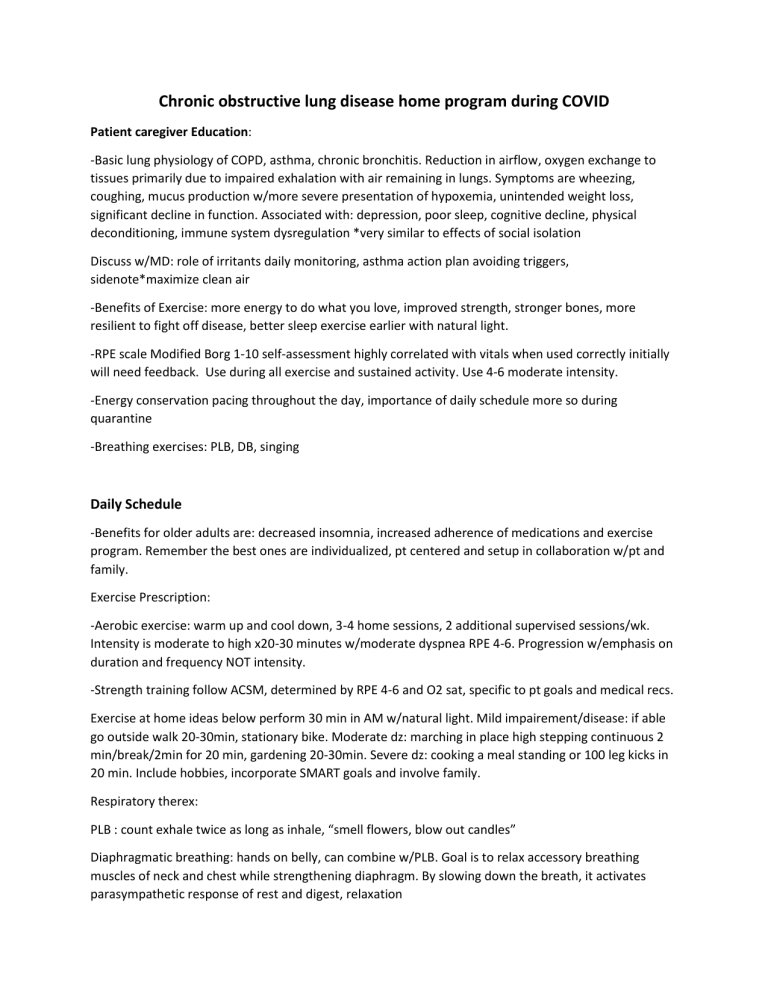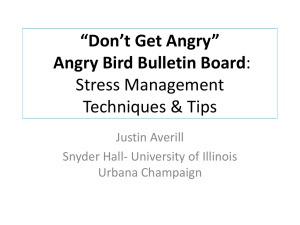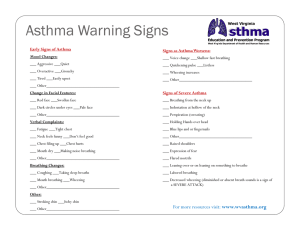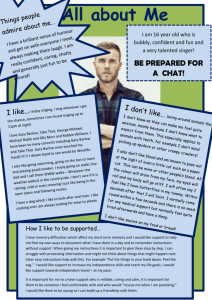
Chronic obstructive lung disease home program during COVID Patient caregiver Education: -Basic lung physiology of COPD, asthma, chronic bronchitis. Reduction in airflow, oxygen exchange to tissues primarily due to impaired exhalation with air remaining in lungs. Symptoms are wheezing, coughing, mucus production w/more severe presentation of hypoxemia, unintended weight loss, significant decline in function. Associated with: depression, poor sleep, cognitive decline, physical deconditioning, immune system dysregulation *very similar to effects of social isolation Discuss w/MD: role of irritants daily monitoring, asthma action plan avoiding triggers, sidenote*maximize clean air -Benefits of Exercise: more energy to do what you love, improved strength, stronger bones, more resilient to fight off disease, better sleep exercise earlier with natural light. -RPE scale Modified Borg 1-10 self-assessment highly correlated with vitals when used correctly initially will need feedback. Use during all exercise and sustained activity. Use 4-6 moderate intensity. -Energy conservation pacing throughout the day, importance of daily schedule more so during quarantine -Breathing exercises: PLB, DB, singing Daily Schedule -Benefits for older adults are: decreased insomnia, increased adherence of medications and exercise program. Remember the best ones are individualized, pt centered and setup in collaboration w/pt and family. Exercise Prescription: -Aerobic exercise: warm up and cool down, 3-4 home sessions, 2 additional supervised sessions/wk. Intensity is moderate to high x20-30 minutes w/moderate dyspnea RPE 4-6. Progression w/emphasis on duration and frequency NOT intensity. -Strength training follow ACSM, determined by RPE 4-6 and O2 sat, specific to pt goals and medical recs. Exercise at home ideas below perform 30 min in AM w/natural light. Mild impairement/disease: if able go outside walk 20-30min, stationary bike. Moderate dz: marching in place high stepping continuous 2 min/break/2min for 20 min, gardening 20-30min. Severe dz: cooking a meal standing or 100 leg kicks in 20 min. Include hobbies, incorporate SMART goals and involve family. Respiratory therex: PLB : count exhale twice as long as inhale, “smell flowers, blow out candles” Diaphragmatic breathing: hands on belly, can combine w/PLB. Goal is to relax accessory breathing muscles of neck and chest while strengthening diaphragm. By slowing down the breath, it activates parasympathetic response of rest and digest, relaxation Singing : start w/easier songs (Silent night, Imagine, Can you Feel the Love tonight), More advanced songs (Jingle Bell Rock, ABC, I’m still standing). Increase challenge by standing, holding a note, or singing more lines without taking a break. Sample schedule- Moderate asthma Morning :wake up by, meds, breakfast, exercise walk, fun relax rest, knit by natural light. Afternoon: lunch, nap, social hour calls, relax. Evening: dinner, breathing exercises singing 15-20min, sleep goal by 10pm. Nutritional considerations: Malnutrition and COPD due to increased metabolic rate work of breathing. Foods rich in flavonoids and antioxidants slow down decline in lung function (veg and fruits) Reference: APTA webinar 4/4/20 “Minimizing the impact of social distancing in older adults” time 47:00-




